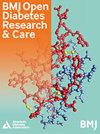Gastric emptying during and following resolution of moderate diabetic ketoacidosis in type 1 diabetes: a case series
IF 3.7
2区 医学
Q2 ENDOCRINOLOGY & METABOLISM
引用次数: 0
Abstract
Introduction To use the ‘gold standard’ technique of scintigraphy to quantify gastric emptying (GE) as soon as practicable during an admission with diabetic ketoacidosis (DKA) and following its resolution at least 7 days later. Research design and methods Five patients with type 1 diabetes, age 29±12 years; Body Mass Index 23±3 kg/m2; hemoglobin A1c 11.3%±1.9%, were studied during an admission with DKA and following its resolution. Solid and liquid GE were measured using scintigraphy. Solid emptying was assessed via the percentage intragastric retention at 100 min and that of liquid by the 50% emptying time. Results There was no difference in either solid or liquid GE at the initial study compared with the follow-up. Median (IQR) solid retention was 47±20 versus 38%±33%, respectively; p=0.31, and time to empty 50% of liquid was 37±25 min versus 35±15 min, p=0.31, at the initial and follow-up GE study, respectively. Conclusions GE of solids and liquids is not affected by moderate DKA, inferring that earlier reintroduction of oral intake may be appropriate. Data are available upon reasonable request.1 型糖尿病患者中度糖尿病酮症酸中毒期间和缓解后的胃排空:病例系列
引言 在糖尿病酮症酸中毒(DKA)患者入院期间,在可行的情况下尽快使用闪烁扫描 "金标准 "技术量化胃排空(GE),并在至少 7 天后观察胃排空情况。研究设计和方法 对五名 1 型糖尿病患者(年龄 29±12 岁;体重指数 23±3 kg/m2;血红蛋白 A1c 11.3%±1.9%)在 DKA 入院期间和缓解后的胃排空情况进行了研究。使用闪烁成像技术测量了固体和液体 GE。固体排空通过 100 分钟的胃内滞留百分比进行评估,液体排空通过 50%的排空时间进行评估。结果 初始研究时的固体或液体胃食管造影与随访时相比均无差异。在初次和随访胃肠道造影检查中,固体潴留中位数(IQR)分别为 47±20% 和 38%±33%,P=0.31;排空 50%液体的时间分别为 37±25 分钟和 35±15 分钟,P=0.31。结论 中度 DKA 不影响固体和液体的胃肠道通气量,推断较早重新引入口服摄入可能是合适的。如有合理要求,可提供相关数据。
本文章由计算机程序翻译,如有差异,请以英文原文为准。
求助全文
约1分钟内获得全文
求助全文
来源期刊

BMJ Open Diabetes Research & Care
Medicine-Endocrinology, Diabetes and Metabolism
CiteScore
9.30
自引率
2.40%
发文量
123
审稿时长
18 weeks
期刊介绍:
BMJ Open Diabetes Research & Care is an open access journal committed to publishing high-quality, basic and clinical research articles regarding type 1 and type 2 diabetes, and associated complications. Only original content will be accepted, and submissions are subject to rigorous peer review to ensure the publication of
high-quality — and evidence-based — original research articles.
 求助内容:
求助内容: 应助结果提醒方式:
应助结果提醒方式:


